人教版(PEP)小学英语小升初复习课件
文档属性
| 名称 | 人教版(PEP)小学英语小升初复习课件 | 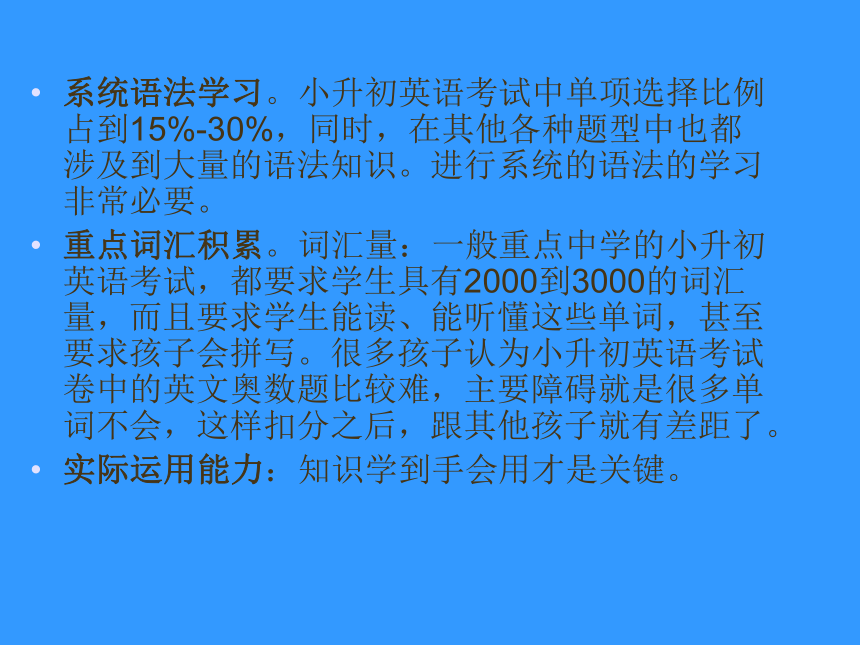 | |
| 格式 | zip | ||
| 文件大小 | 359.6KB | ||
| 资源类型 | 教案 | ||
| 版本资源 | 人教版(PEP) | ||
| 科目 | 英语 | ||
| 更新时间 | 2018-05-21 16:08:16 | ||
图片预览



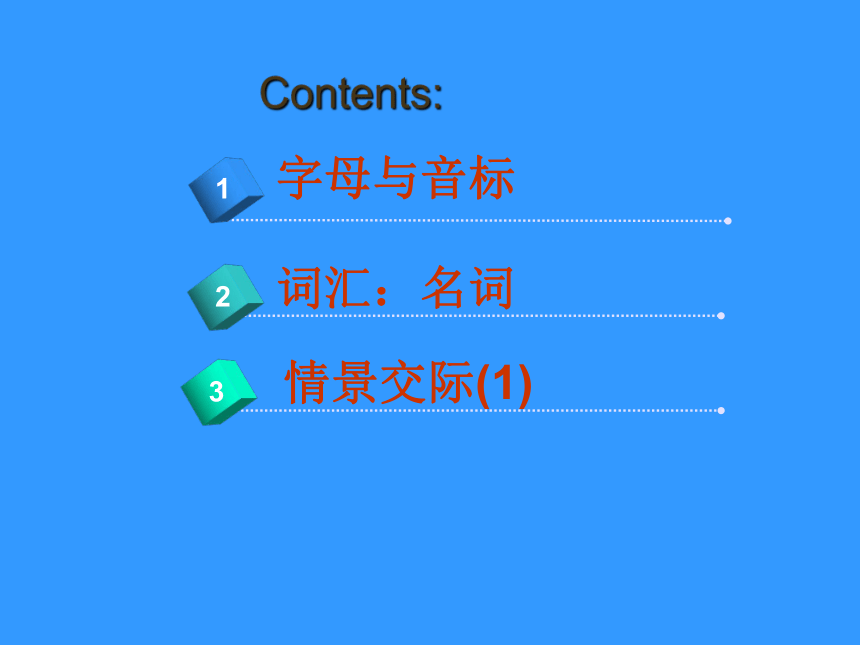

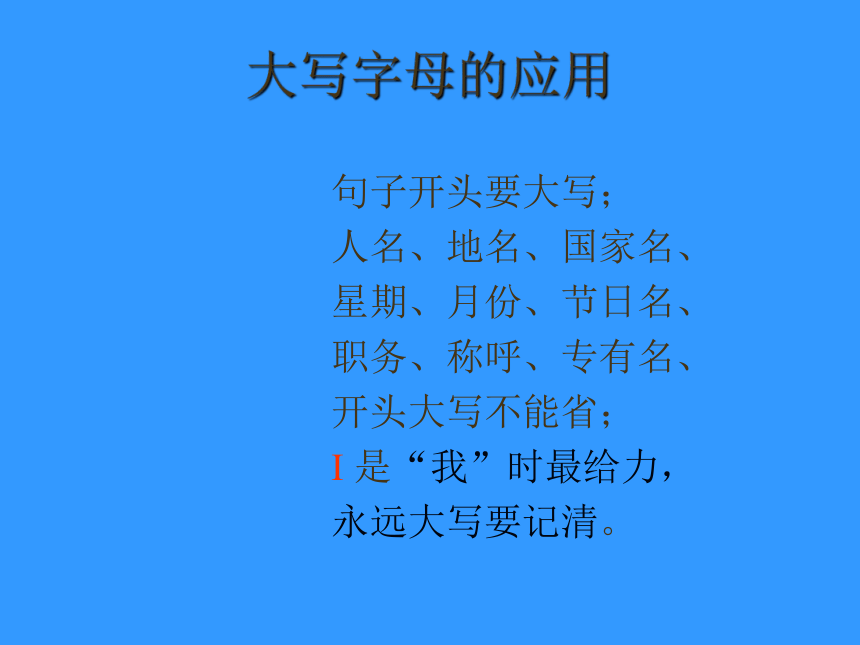
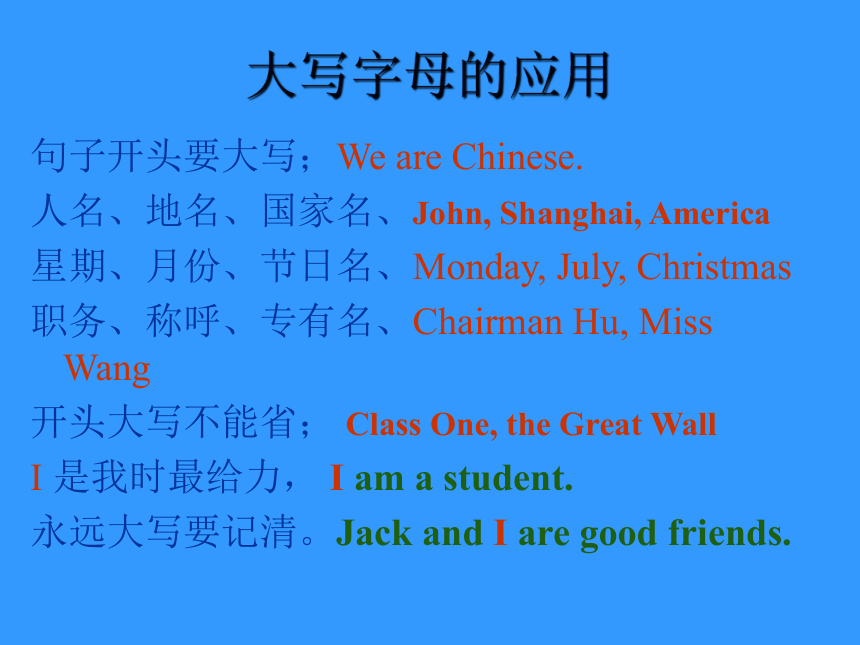
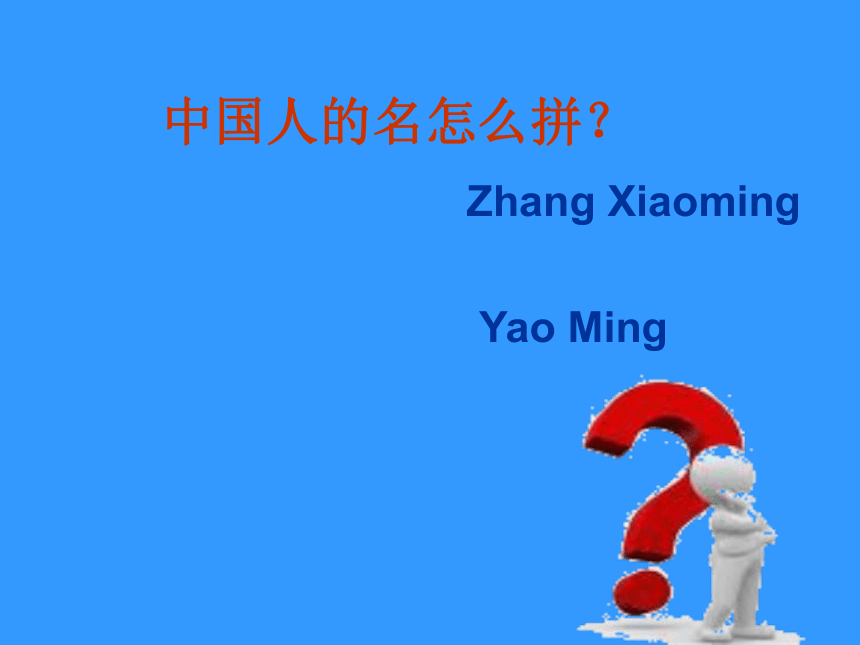

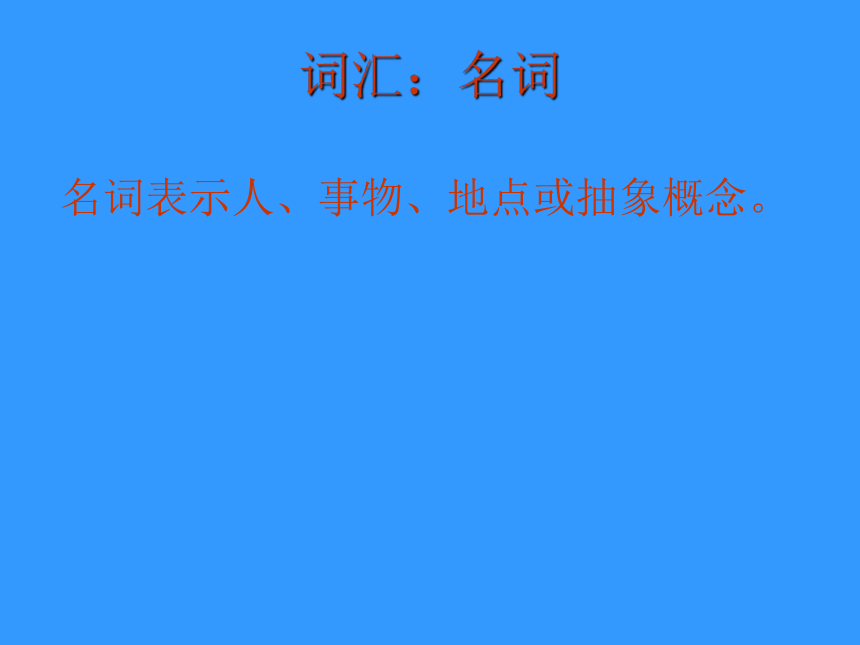
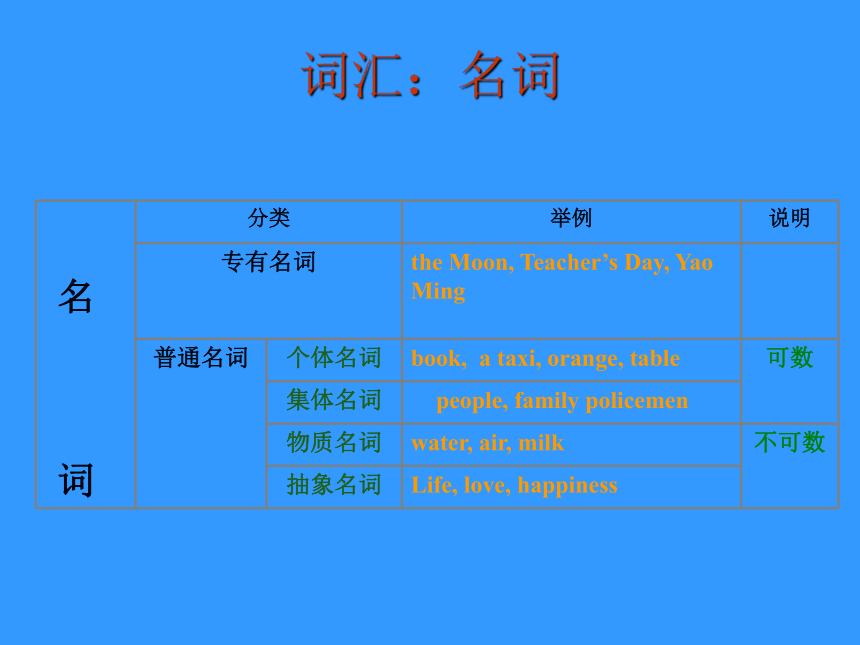
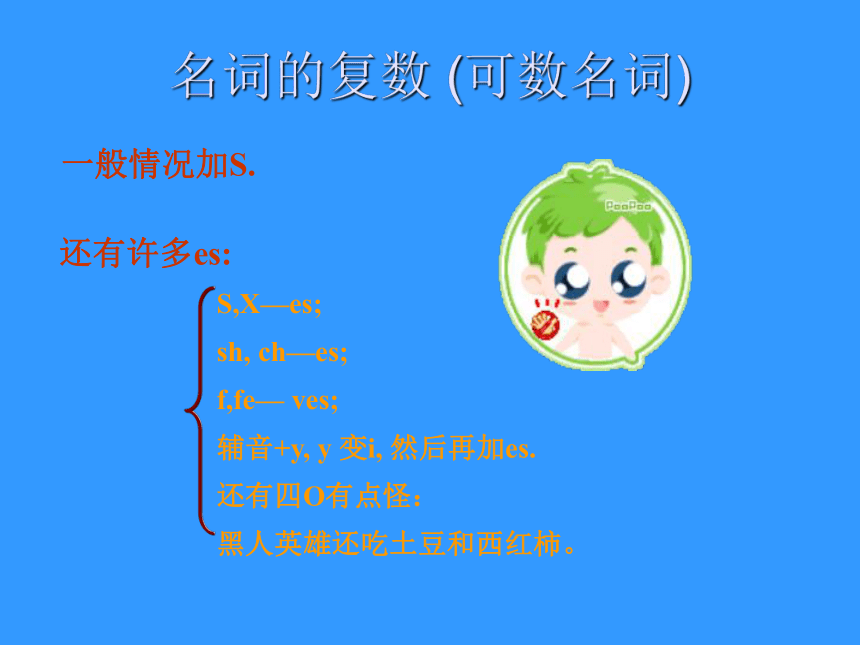
文档简介
课件124张PPT。系统语法学习。小升初英语考试中单项选择比例占到15%-30%,同时,在其他各种题型中也都涉及到大量的语法知识。进行系统的语法的学习非常必要。
重点词汇积累。词汇量:一般重点中学的小升初英语考试,都要求学生具有2000到3000的词汇量,而且要求学生能读、能听懂这些单词,甚至要求孩子会拼写。很多孩子认为小升初英语考试卷中的英文奥数题比较难,主要障碍就是很多单词不会,这样扣分之后,跟其他孩子就有差距了。
实际运用能力:知识学到手会用才是关键。小升初英语复习大全 小升初英语(1) 冲刺课程 Contents: 123 词汇:名词情景交际(1)字母与音标字母与音标26个字母,5个元音字母:Aa, Ee, Ii, Oo, Uu
大写字母的应用句子开头要大写;
人名、地名、国家名、
星期、月份、节日名、
职务、称呼、专有名、
开头大写不能省;
I 是“我”时最给力,
永远大写要记清。大写字母的应用句子开头要大写;We are Chinese.
人名、地名、国家名、John, Shanghai, America
星期、月份、节日名、Monday, July, Christmas
职务、称呼、专有名、Chairman Hu, Miss Wang
开头大写不能省; Class One, the Great Wall
I 是我时最给力, I am a student.
永远大写要记清。Jack and I are good friends. 中国人的名怎么拼?
Zhang Xiaoming
Yao Ming音标词汇:名词
名词表示人、事物、地点或抽象概念。词汇:名词名词的复数 (可数名词) 一般情况加S.
还有许多es:
S,X—es;
sh, ch—es;
f,fe— ves;
辅音+y, y 变i, 然后再加es.
还有四O有点怪:
黑人英雄还吃土豆和西红柿。名词的复数(可数名词) 一般情况加S:books, table, eggs, pens
还有许多es:
S,X—es; glasses, boxes
Sh, ch—es; watches, dishes
F,fe— ves; knife- knives leaf-leaves
辅音+y, y 变i, 然后再加es. story-stories
还有四O有点怪:
黑人英雄还吃土豆和西红柿。
(Negro-negroes; hero-heroes;
tomato-tomatoes; potato-potatoes)特例:roof— roofs 屋顶
Safe— safes 保险箱
名词的复数(可数名词)名词复数形式的不规则变化
单复同形:羊遇路人(羊、鱼、鹿、中国人)
(sheep, fish, deer, Chinese)
OO变ee: 鹅的脚丫(牙)
(goose-geese, foot-feet,
tooth-teeth)
复作单: 新闻学科
news, maths, physics, politics
只有复: scissors, trousers, compasses, sunglasses
元音变化:man-men, policeman-policemen不可数名词 不可以用数字数出来的名词叫不可数名词, 没有单复数之分。
a piece of paper
two cups of tea名词所有格名词中表示所有关系的形式叫名词所有格。
有两种构成方法:
名词+ Of + 名词
名词+ ’ s
名词所有格一般情况: 名+’S Tom’s book.
2. 词尾s或es结尾的名词+’
the teachers’ books, the kids’ apples
the students’ bags
3. 词尾不是S的名词复数+’S
the children’s toys, the women’s clothes
the men’s bikes名词所有格4. 表示各自的所有关系时,名词末尾均加+’S
Jim’s and Tom’s bedrooms
Andy’s and Susan’s mothers
5. 表示共同的所有关系时,在最后一个词后加’S
Andy and Susan’s mother
6. 表示无生命的东西的所有关系:名+ of + 名
the top of the mountain
the windows of the room情景交际(1)2、介绍
1)I’m —
My name is —
This is— 这是
May I introduce Tom to you?
让我将TOM介绍给你吧。情景交际(1)1、问候:Hello!/ Hi
Good morning/ afternoon/ evening
Nice/Glad to meet/see you!
(见到你真高兴)
How are you? 你好吗?
How do you do?你好!
(正式,初次见面)情景交际(1)3、询问
1) What’s your name?/ May I have your name?
2) What’s this/ that in English?
这个/那个用英语怎么说?
3) What’s she? 她是干什么工作的?
What do you do?你是做什么工作的?
What’s your job? 你的工作是什么?
4) What’s the time?/ What time is it?
几点了?
情景交际(1)4、告别
Goodbye!
Bye-bye!
See you (later)!
Good night! 晚安 小升初英语(2) 冲刺课程 Contents: 123 词汇:冠词情景交际(2)音标冠词 冠词是用在名词之前,说明名词所表示的人或事物的词。
不定冠词:a,
an
冠词
定冠词:the可数名词单数前,“一个” “一种”元音开头的可数名词单数前种情况要记清不定冠词:a/ ana book, a table, a woman, a teacher (一个)
a panda is a lovely animal.
熊猫是一种可爱的动物。
an egg, an apple, an orange, an old man
使用a/ an 的习语have a look:看一看
have a fever:发烧
have a talk:谈话
have a rest:休息一下
have a good time:过得愉快
have a nice trip: 旅途愉快
have a cold/ catch a cold:感冒
in a word: 总而言之
give a lesson:教课定冠词: the定冠词用在下列情况:
特指双熟悉,上文已提及;
世上独无二,序数最高级;
某些专有名,习语及乐器。
定冠词: the
以上口诀归纳了用定冠词的一般情况,即:
①特指某些人或物
②谈话双方都熟悉的人或事
③上文已经提到的人或事
④世界上独一无二的事物前
⑤序数词和形容词最高级前
⑥某些专有名词前
⑦一些习惯短语(如:in the day等)中和乐器前(如:play the violin / piano)。
特指双熟悉:特指某些人或物。
谈话双方都熟悉的人或事。
Do you like the picture on the wall?
The girl in red is my sister.
The book on the left is mine.
上文已提及:上文已经提到的人或事.
There is a hamburger on the table.
The hamburger is Li Lin’s.
This is a pen. The pen is new.
These are books. The books are teachers’. 世上独无二:世界上独一无二的事物前.
the Sun,
the Moon,
the Earth (地球)
序数最高级:序数词前
和形容词最高级前
I am the second child in my family.
(我在家排行老二)
The first book is English book. 第一本书是英语书。
He is the tallest student in our class.
他在我们班个子最高。
Rose is the most beautiful flower.
玫瑰花是最美的花。某些专有名:某些专有名词前用the.
the Yellow River(黄河)
the Great Wall(长城)
习语及乐器:一些习惯短语中和乐器前.
in the morning, in the evening, in the afternoon
go to the zoo: 去公园
at the beginning:开头
in the end: 终于,最后
in the middle of : 在—中间
on the left : 在左边
on the right: 在右边
by the way : 顺便说一下
习语及乐器:一些习惯短语中和乐器前.
play the piano: 弹钢琴
play the violin: 拉小提琴
play the guitar:弹吉他另外:形容词前加the, 表示一类人。
姓氏复数前加the,表示一家人。
We should help the old. 我们应该帮助老年人
The Smiths are having dinner together.
史密斯一家正在共进晚餐。不用冠词的情况: 下列情况应免冠,代词限定名词前;
专有名词不可数,学科球类三餐饭;
复数名词表泛指,两节星期月份前;
颜色语种和国名,称呼习语及头衔。
口诀主要概括了一般应“免冠”的情况①代词限定名词前;名词前已有作定语用的this、that、some、any my等限定词。
This is my pen.
There are some students. 专有名词不可数: China, juice
学科球类三餐饭:表示学科的、球类活动的名词前及三餐总称前。
Chinese is my favorite subject. 语文是我最爱的科目。
My brother likes playing basketball. 我哥哥爱打篮球。
He usually has breakfast at 7 o’clock. 他经常7点吃早饭
复数名词表泛指:复数名词表示泛指(一类人或事)时。
Human beings love nature. 人类爱大自然。两节星期月份前:节日、季节、星期、月份前。
Summer is hot.
Today is Sunday.
We all like Children’s Day .
We hold sports meeting in June.
(我们六月份举行运动会。) 颜色语种和国名:
Her coat is yellow.
Chinese is my mother tongue.
We all like China.称呼习语及头衔:在称呼或表示头衔的名词前;某些习惯短语中(如:in bed、go to school等)。
小升初英语(3) 冲刺课程 Contents: 123 词汇:代词(一)情景交际(二)音标代词一、人称代词
二、物主代词
三、反身代词
四、疑问代词一、人称代词1.人称代词有人称、数和格的变化
一、人称代词2.人称代词的用法
①主格用作主语或表语。
例:We are students. 我们是学生。
②人称代词宾格用作宾语,但在口语中宾格也用作表语。
例:Please listen to me. 请注意听。
③英语中由动词加副词组成动词短语,如果用代词作它的宾格,代词要放在动词和副词中间。
例:It’s too hot. Please take it off.
天太热了,把它脱掉吧。二、物主代词物主代词是表示所属关系的代词。包括形容词性物主代词(my, your, his, her, its, our, their)和名词性物主代词(mine, his, yours, hers, its, ours, theirs)。二、物主代词二、物主代词1.物主代词
①形容词性物主代词起形容词作用,用作定语,通常与名词构成词组,不能单独使用。
例:Her pen is white. 她的笔是白色的。
②名词性物主代词起名词的作用,可以独立使用,充当句子的某个成分,相当于形容词性物主代词的名词构成的词组。
例:This is your pencil. Where is mine? (my pencil)
这是你的铅笔。我的(铅笔)在哪儿?二、物主代词③“of + 名词性物主代词” 这种双重性格,表示部分概念。
例:He is a friend of mine. 他是我的一个朋友。二、物主代词2.指示代词
指示代词有this(这个),that(那个),these(这些),those(那些)。
①this, that表单数,these, those表复数;this, these指近处的人或物,that, those指远处的人或物。
例:Don’t give these to them. Give them those.
别把这些给他们,把那些给他们吧。
二、物主代词②this, that常用于电话用语中,表达“我是……” “你是……”。
例:—Hello! This is Tom. Is that John?
你好!我是汤姆。你是约翰吗?
—No, this is Bill.
不是,我是比尔。二、物主代词3.反身代词
反身代词是表示反射或强调的代词,表示我自己(myself)、你自己(yourself)、他/她/它自己(himself / herself / itself)、我们自己(ourselves)、他们自己(themselves)等。二、物主代词二、物主代词①反身代词在句子中可以作宾语、表语、同位语
例:The poor boy was himself.
那个可怜的男孩就是他自己。
②当主语的宾语为同一个人或物时,宾语用反身代词表示反射。
例:Susan saw herself in the mirror.
苏珊在镜子里看到了她自己。二、物主代词③反身代词可以用来表示强调。此时,反身代词通常放在名词、代词之后,也可以放在句尾。
例:I myself can finish it.
我能自己完成这件事。二、物主代词4.疑问代词
疑问代词是用来构成特殊疑问句的代词,这类代词有:who 谁,whose 谁的,what 什么,which 哪一个、哪些。疑问代词一般放在句首,句子用降调读。
例:What’s the time? 现在几点了?
What’s your name? 你叫什么名字?
Who’s not here today? 今天谁没来?
Whose computer is that? 那是谁的电脑?
Which class are you in? 你在哪个班?二、物主代词5.不定代词
不定代词是不指明代替任何特定名词(形容词)的代词,这类代词有:some, any, many, much, few, a few, little, a little。some一般用于肯定句中,any一般用于否定句或疑问句中。表示代替或修饰可数名词的有:many, few, a few。代替或修饰不可数名词的有:much, little, a little。其中a few, a little表示肯定;little, few表示否定 小升初英语(3) 冲刺课程 Contents: 123 词汇:代词(一)情景交际(二)音标代词一、人称代词
二、物主代词
三、反身代词
四、疑问代词一、人称代词1.人称代词有人称、数和格的变化
一、人称代词2.人称代词的用法
①主格用作主语或表语。
例:We are students. 我们是学生。
②人称代词宾格用作宾语,但在口语中宾格也用作表语。
例:Please listen to me. 请注意听。
③英语中由动词加副词组成动词短语,如果用代词作它的宾格,代词要放在动词和副词中间。
例:It’s too hot. Please take it off.
天太热了,把它脱掉吧。二、物主代词物主代词是表示所属关系的代词。包括形容词性物主代词(my, your, his, her, its, our, their)和名词性物主代词(mine, his, yours, hers, its, ours, theirs)。二、物主代词二、物主代词1.物主代词
①形容词性物主代词起形容词作用,用作定语,通常与名词构成词组,不能单独使用。
例:Her pen is white. 她的笔是白色的。
②名词性物主代词起名词的作用,可以独立使用,充当句子的某个成分,相当于形容词性物主代词的名词构成的词组。
例:This is your pencil. Where is mine? (my pencil)
这是你的铅笔。我的(铅笔)在哪儿?二、物主代词③“of + 名词性物主代词” 这种双重性格,表示部分概念。
例:He is a friend of mine. 他是我的一个朋友。二、物主代词2.指示代词
指示代词有this(这个),that(那个),these(这些),those(那些)。
①this, that表单数,these, those表复数;this, these指近处的人或物,that, those指远处的人或物。
例:Don’t give these to them. Give them those.
别把这些给他们,把那些给他们吧。
二、物主代词②this, that常用于电话用语中,表达“我是……” “你是……”。
例:—Hello! This is Tom. Is that John?
你好!我是汤姆。你是约翰吗?
—No, this is Bill.
不是,我是比尔。二、物主代词3.反身代词
反身代词是表示反射或强调的代词,表示我自己(myself)、你自己(yourself)、他/她/它自己(himself / herself / itself)、我们自己(ourselves)、他们自己(themselves)等。二、物主代词二、物主代词①反身代词在句子中可以作宾语、表语、同位语
例:The poor boy was himself.
那个可怜的男孩就是他自己。
②当主语的宾语为同一个人或物时,宾语用反身代词表示反射。
例:Susan saw herself in the mirror.
苏珊在镜子里看到了她自己。二、物主代词③反身代词可以用来表示强调。此时,反身代词通常放在名词、代词之后,也可以放在句尾。
例:I myself can finish it.
我能自己完成这件事。二、物主代词4.疑问代词
疑问代词是用来构成特殊疑问句的代词,这类代词有:who 谁,whose 谁的,what 什么,which 哪一个、哪些。疑问代词一般放在句首,句子用降调读。
例:What’s the time? 现在几点了?
What’s your name? 你叫什么名字?
Who’s not here today? 今天谁没来?
Whose computer is that? 那是谁的电脑?
Which class are you in? 你在哪个班?二、物主代词5.不定代词
不定代词是不指明代替任何特定名词(形容词)的代词,这类代词有:some, any, many, much, few, a few, little, a little。some一般用于肯定句中,any一般用于否定句或疑问句中。表示代替或修饰可数名词的有:many, few, a few。代替或修饰不可数名词的有:much, little, a little。其中a few, a little表示肯定;little, few表示否定 小升初英语(4) 冲刺课程 Contents: 123 词汇:形容词、副词 比较级、最高级情景交际(三)音标
(一)、形容词的比较级 1、形容词比较级在句子中的运用:两个事物或人的比较用比较级,比较级后面一般带有单词than。比较级前面可以用more, a little来修饰表示程度。than后的人称代词用主格(口语中可用宾格)。 2.形容词加er的规则: ⑴ 一般在词尾加er ; ⑵ 以字母e 结尾,加r ; ⑶ 以一个元音字母和一个辅音字母结尾,应双写末尾的辅音字母,再加er ; ⑷ 以“辅音字母+y”结尾,先把y变i,再加er 。 3.不规则形容词比较级: ??good-better, beautiful-more beautiful (二)副词的比较级 1.形容词与副词的区别 (有be用形,有形用be;有动用副,有副用动) ??⑴在句子中形容词一般处于名词之前或be动词之后 ⑵副词在句子中最常见的是处于实义动词之后 2.副词比较级的变化规则基本与形容词比较级相同 (不规则变化:well-better, far-farther) 小升初英语(5) 冲刺课程 Contents: 123 词汇:数词情景交际(三)音标一、基数词
(1)1-20
one,two,three,four,five,six,seven,eight,nine,ten,eleven,twelve,thirteen,fourteen,fifteen, sixteen,seventeen,eighteen,nineteen,twenty
(2)21-99 先说“几十”,再说“几”,中间加连字符。
23→twenty-three,34→thirty-four,45→forty—five,56→fifty-six,67→sixty-seven,78→seventy-eight,89→eighty-nine,91→ninety-one(3)101—999先说“几百”,再加and,再加末两位数或末位数;
586→five hundred and eighty-six,803→eight hundred and three
(4)l,000以上,先从右往左数,每三位数加一个“,”,第一个“,”前为thousand.第二个“,”前为million,第三个“,”前为billion??
1,001→one thousand and one
?18,423→eighteen thousand,four hundred and twenty-three
?6,260,309→six million two hundred and sixty thousand three hundred and nine
??750,000,000,000→seven hundred and fifty billion
二、序数词
(1)一般在基数词后加th
eg.four→fourth,thirteen→thirteenth
(2)不规则变化
one→first,two→second,three→third,five→fifth,eight→eighth,nine→ninth,twelve—twelfth
(3)以y结尾的十位整数,变y为ie再加th
twenty→twentieth, forty→fortieth, ninety→ninetieth
?(4)从二十一后的“几十几”直至“几百几十几”或“几千几百几十几”只将个位的基数词变为序数词。
twenty-first,two hundred and forty-fifth
基数词转为序数词的口诀:
基变序,有规律,词尾加上-th.
一,二,三,特殊记,词尾字母t,d,d.
八去t,九去e, ve要用f替。
ty将y变成i,th前面有个e.
若是碰到几十几,前用基来后用序。
小升初英语(6) 冲刺课程 Contents: 123 词汇:介词情景交际(三)音标介词介词是表示名词、代词和句中其他词之间关系的词,主要表示时间、地点、方位等
时间:on, in, at, before
方位:on, over, under, below
介词 动向:into, out of, along, across,
through
方式:by, with, in一、时间介词On, in, at 都表示时间。但有区别:
on表示具体的时间,如星期几,几号
on Monday 在星期一
on March 5th 在3月5号一、时间介词On, in, at 都表示时间。但有区别:
In 指某一段时间,用在表示某年、某月、某季节或早上、下午、晚上。如:
In the morning
In 2008
In February 在二月
一、时间介词On, in, at 都表示时间。但有区别:
at 用在时刻和中午的前面,表示具体的时间点
at 6: 00 在6点
at noon 在中午一、时间介词before 和after 的用法
before 表示在----之前
Wash your hands before meals.
饭前要洗手。
after 表示在-----之后
They often do their homework after school.
他们经常放学后写作业。一、时间介词from----to----:表示从----到----
We go to school from Monday to Friday.
我们从周一到周五上学。二、方位介词1.on,over和above二、方位介词2.in front of和in the front of三、动向介词动向介词是指该介词出了具有方向性外,还伴随着动作,如through,into等。
across 和 through四、方式介词表示方式的介词主要有by,with,in等。
1.by表示“靠、用”。如:
I go to school by bike.我骑自行车上学。
2.with表示“与……一起”或“用……”。如
I cut the apple with a knife.我用刀切苹果。
3.in表示“用某种语言,以某种方式”。
She can speak in English.她会讲英语。 小升初英语(6) 冲刺课程 Contents: 123 词汇:动词情景交际(三)音标动词的四种时态:
(1)一般现在时:
一般现在时的构成 1. be动词:主语+be(am, is, are)+其它。如: I am a boy. 我是一个男孩。 2. 行为动词:主语+行为动词(+其它)。 如: We study English. 我们学习英语。 当主语为第三人称单数(he, she, it)时,要在动词后加"-s"或"-es"。如:Mary likes Chinese.玛丽喜欢汉语。 动词+s的变化规则 1.一般情况下,直接加-s,如:cook-cooks, milk-milks 2.以s. x. sh. ch. o结尾,加-es,如:guess-guesses, wash-washes, watch-watches, go-goes 3.以“辅音字母+y”结尾,变y为i, 再加-es,如:study-studies (2)一般过去时:
动词过去式详解 动词的过去式的构成规则有:
A、规则动词
①????一般直接在动词的后面加ed:如 worked , learned , cleaned , visited
② 以e结尾的动词直接加d:如 lived , danced , used
③????以辅音字母加y结尾的动词要改y为i再加ed(此类动词较少)如 study – studied carry – carried worry – worried (注意play、stay不是辅音字母加y,所以不属于此类)
④ 双写最后一个字母(此类动词较少)如 stopped
B、不规则动词(此类词并无规则,须熟记)小学阶段要记住以下动词的原形和过去式:sing – sang , eat – ate ,
see – saw , have – had , do – did , go – went , take – took , buy – bought , get – got , read – read ,fly – flew , am/is – was ,
are – were , say – said , leave – left , swim – swam , tell – told , draw – drew , come – came , lose – lost , find – found , drink – drank , hurt – hurt , feel – felt(3)一般将来时:
基本结构: ①be going to + do;
②will+ do. be going to = will
I am going to go swimming tomorrow(明天). = I will go swimming tomorrow.
(4)现在进行时: am,is,are+动词现在分词
动词现在分词详解 动词的ing形式的构成规则:
①??? 一般的直接在后面加上ing , 如doing , going , working , singing , eating
② 以e 结尾的动词,要先去e再加ing ,如having , writing
③ 双写最后一个字母的(此类动词极少)有:running , swimming , sitting , getting第二部分 句法1.陈述句
(1)肯定句:是指用肯定的语气来陈述的句子,如:I’m a student. She is a doctor. He works in a hospital.
There are four fans in our classroom. He will eat lunch at 12:00. I watched TV yesterday evening.
(2)、否定句:含有否定词或表示否定意义词的句子,如:I’m not a student. She is not (isn’t) a doctor.
He will not (won’t) eat lunch at 12:00. I did not (didn’t) watch TV yesterday evening.
He does not (doesn’t) work in a hospital. There are not (aren’t) four fans in our classroom. 2. 疑问句
一般疑问句:是指询问事实的句子,此类句子必须用“yes”,或“no”来回答。
特殊疑问句:以特殊疑问词(what , where , who , which , when , whose , why , how等)开头引导的句子。此类句子应该问什么就答什么,不能用“yes 、no”来回答。
3.There be句型
There be 句型与have, has的区别 1、There be 句型表示:在某地有某物(或人)
2、在there be 句型中,主语是单数,be 动词用is ; 主语是复数,be 动词用are ; 如有几件物品,be 动词根据最*近be 动词的那个名词决定。 3、there be 句型的否定句在be 动词后加not , 一般疑问句把be 动词调到句首。 4、there be句型与have(has) 的区别:there be 表示在某地有某物(或人);have(has) 表示某人拥有某物。 5、some 和any 在there be 句型中的运用:some 用于肯定句, any 用于否定句或疑问句。 6、and 和or 在there be句型中的运用:and 用于肯定句, or 用于否定句或疑问句。 7、针对数量提问的特殊疑问句的基本结构是: ? ?How many +? ?? ?? ?名词复数 + are there + 介词短语? ? ?How much + 不可数名词 + is there + 介词短语? 8、针对主语提问的特殊疑问句的基本结构是: ? ?What’s + 介词短语? 五、专项练习英语重读闭音节就是所谓的元音字母不是发它本身的字母音,重读闭音节就是指在一个音节中,以辅音因素结尾的而且是重读音节的音节比如apple 划音节就因该是ap/ple 前面那个ap 是一个音节以辅音因素p结尾就是闭音节。
重读闭音节三要素:
1. 必须是重读音节;
2. 最后只有一个辅音字母;
3.元音字母发短元音 重读闭音节就要双写.重读闭音节即两个辅音中间夹一个元音.
如:sit---sitting
begin---beginning(重读在gin这个音节上,相当与把gin改成双写的)
像travel这种重读不在的vel,可以为travelled,也可以是traveled.
举两个很经典的例子:
forbid---forbidding (重读闭音节,双写)
prohibit---prohibiting (重读在第二音节,非重读闭音节,不双写)
元音:a e i o u
辅音:b d g v r z n p m t c (k g) f l s h j x
重读闭音节法:两个辅音间夹着一个元音。六、现在分词(ing)变化规则:
1 .一般情况下直接加ing
think---thinking
sleep---sleeping
study---studying
speak---speaking
say---saying2 .以不发音的字母e结尾的单词,去掉字母e,再加ing这里的e必须不发音,若发音,则不能去掉,如see→seeing
wake---waking
make---making
come---coming
take---taking
leave---leaving
have---having
dance----dancing
ride----riding
write---writing3.以重读闭音节结尾,呈现“辅,元,辅”结构的动词,先双写末尾的辅音字母,再加ing
stop---stopping
sit---sitting
run---running4. 以ie结尾的动词,把ie改为y ,再加ing lie---lying
5.以重读闭音节结尾,呈现“辅,元,辅”结构的动词,先双写末尾的辅音字母,再加ing 。
begin,cut, get,
hit, run, sit, stop, set, swim, fit, dig, forget等。七、动词过去式(-ed)变化规律1、一般情况下,动词词尾加 -ed ,如:
work ---worked play---played
wanted----wanted act----acted
2、以不发音的 -e 结尾动词,动词词尾加 -d,如:
live---lived move----moved
taste---tasted hope---hoped 3、以辅音字母 + y结尾的动词,把-y变为-i 再加-ed,如:
study---studied copy---copied cry---cried carry---carried
4、以一个辅音字母结尾的重读闭音节动词,双写词尾辅音字母,再加 -ed,如:
stop ---stopped 5、不规则动词的过去式变化规律性不强,须多加记忆。
go – went make – made get – got
buy - bought come - came fly-flew 形容词比较级(er)和 最高级(est)变化规律1、一般直接在词尾加er/est: 如tall—taller—tallest.
great strong quick long fresh few tall
2、以e结尾的单词去e加er/est: 如wide—wider—widest.
nice brave fine strange late wide3、以辅音字母加y结尾的单词,把y变为i,再加er/est: 如busy—busier—busiest.
lazy ugly happy lucky healthy busy
4、以重读闭音节结尾且末尾只有一个辅音字母的单词,双写末尾的辅音字母,再加er/est: 如big—bigger—biggest.
fat red thin hot wet5、部分双音节词,多音节词在词前面加more或 most(比较级more + adj; 最高级most + adj): 如serious—more serious—most serious.
interesting delicious carefully popular careful useful dangerous beautiful important terrible active serious
6、不规则变化:
good / well—better—best. bad / ill—worse—worst.
many / much—more—most. little / few—less—least.
far—farther / further—farthest / furthest.Thank you!
重点词汇积累。词汇量:一般重点中学的小升初英语考试,都要求学生具有2000到3000的词汇量,而且要求学生能读、能听懂这些单词,甚至要求孩子会拼写。很多孩子认为小升初英语考试卷中的英文奥数题比较难,主要障碍就是很多单词不会,这样扣分之后,跟其他孩子就有差距了。
实际运用能力:知识学到手会用才是关键。小升初英语复习大全 小升初英语(1) 冲刺课程 Contents: 123 词汇:名词情景交际(1)字母与音标字母与音标26个字母,5个元音字母:Aa, Ee, Ii, Oo, Uu
大写字母的应用句子开头要大写;
人名、地名、国家名、
星期、月份、节日名、
职务、称呼、专有名、
开头大写不能省;
I 是“我”时最给力,
永远大写要记清。大写字母的应用句子开头要大写;We are Chinese.
人名、地名、国家名、John, Shanghai, America
星期、月份、节日名、Monday, July, Christmas
职务、称呼、专有名、Chairman Hu, Miss Wang
开头大写不能省; Class One, the Great Wall
I 是我时最给力, I am a student.
永远大写要记清。Jack and I are good friends. 中国人的名怎么拼?
Zhang Xiaoming
Yao Ming音标词汇:名词
名词表示人、事物、地点或抽象概念。词汇:名词名词的复数 (可数名词) 一般情况加S.
还有许多es:
S,X—es;
sh, ch—es;
f,fe— ves;
辅音+y, y 变i, 然后再加es.
还有四O有点怪:
黑人英雄还吃土豆和西红柿。名词的复数(可数名词) 一般情况加S:books, table, eggs, pens
还有许多es:
S,X—es; glasses, boxes
Sh, ch—es; watches, dishes
F,fe— ves; knife- knives leaf-leaves
辅音+y, y 变i, 然后再加es. story-stories
还有四O有点怪:
黑人英雄还吃土豆和西红柿。
(Negro-negroes; hero-heroes;
tomato-tomatoes; potato-potatoes)特例:roof— roofs 屋顶
Safe— safes 保险箱
名词的复数(可数名词)名词复数形式的不规则变化
单复同形:羊遇路人(羊、鱼、鹿、中国人)
(sheep, fish, deer, Chinese)
OO变ee: 鹅的脚丫(牙)
(goose-geese, foot-feet,
tooth-teeth)
复作单: 新闻学科
news, maths, physics, politics
只有复: scissors, trousers, compasses, sunglasses
元音变化:man-men, policeman-policemen不可数名词 不可以用数字数出来的名词叫不可数名词, 没有单复数之分。
a piece of paper
two cups of tea名词所有格名词中表示所有关系的形式叫名词所有格。
有两种构成方法:
名词+ Of + 名词
名词+ ’ s
名词所有格一般情况: 名+’S Tom’s book.
2. 词尾s或es结尾的名词+’
the teachers’ books, the kids’ apples
the students’ bags
3. 词尾不是S的名词复数+’S
the children’s toys, the women’s clothes
the men’s bikes名词所有格4. 表示各自的所有关系时,名词末尾均加+’S
Jim’s and Tom’s bedrooms
Andy’s and Susan’s mothers
5. 表示共同的所有关系时,在最后一个词后加’S
Andy and Susan’s mother
6. 表示无生命的东西的所有关系:名+ of + 名
the top of the mountain
the windows of the room情景交际(1)2、介绍
1)I’m —
My name is —
This is— 这是
May I introduce Tom to you?
让我将TOM介绍给你吧。情景交际(1)1、问候:Hello!/ Hi
Good morning/ afternoon/ evening
Nice/Glad to meet/see you!
(见到你真高兴)
How are you? 你好吗?
How do you do?你好!
(正式,初次见面)情景交际(1)3、询问
1) What’s your name?/ May I have your name?
2) What’s this/ that in English?
这个/那个用英语怎么说?
3) What’s she? 她是干什么工作的?
What do you do?你是做什么工作的?
What’s your job? 你的工作是什么?
4) What’s the time?/ What time is it?
几点了?
情景交际(1)4、告别
Goodbye!
Bye-bye!
See you (later)!
Good night! 晚安 小升初英语(2) 冲刺课程 Contents: 123 词汇:冠词情景交际(2)音标冠词 冠词是用在名词之前,说明名词所表示的人或事物的词。
不定冠词:a,
an
冠词
定冠词:the可数名词单数前,“一个” “一种”元音开头的可数名词单数前种情况要记清不定冠词:a/ ana book, a table, a woman, a teacher (一个)
a panda is a lovely animal.
熊猫是一种可爱的动物。
an egg, an apple, an orange, an old man
使用a/ an 的习语have a look:看一看
have a fever:发烧
have a talk:谈话
have a rest:休息一下
have a good time:过得愉快
have a nice trip: 旅途愉快
have a cold/ catch a cold:感冒
in a word: 总而言之
give a lesson:教课定冠词: the定冠词用在下列情况:
特指双熟悉,上文已提及;
世上独无二,序数最高级;
某些专有名,习语及乐器。
定冠词: the
以上口诀归纳了用定冠词的一般情况,即:
①特指某些人或物
②谈话双方都熟悉的人或事
③上文已经提到的人或事
④世界上独一无二的事物前
⑤序数词和形容词最高级前
⑥某些专有名词前
⑦一些习惯短语(如:in the day等)中和乐器前(如:play the violin / piano)。
特指双熟悉:特指某些人或物。
谈话双方都熟悉的人或事。
Do you like the picture on the wall?
The girl in red is my sister.
The book on the left is mine.
上文已提及:上文已经提到的人或事.
There is a hamburger on the table.
The hamburger is Li Lin’s.
This is a pen. The pen is new.
These are books. The books are teachers’. 世上独无二:世界上独一无二的事物前.
the Sun,
the Moon,
the Earth (地球)
序数最高级:序数词前
和形容词最高级前
I am the second child in my family.
(我在家排行老二)
The first book is English book. 第一本书是英语书。
He is the tallest student in our class.
他在我们班个子最高。
Rose is the most beautiful flower.
玫瑰花是最美的花。某些专有名:某些专有名词前用the.
the Yellow River(黄河)
the Great Wall(长城)
习语及乐器:一些习惯短语中和乐器前.
in the morning, in the evening, in the afternoon
go to the zoo: 去公园
at the beginning:开头
in the end: 终于,最后
in the middle of : 在—中间
on the left : 在左边
on the right: 在右边
by the way : 顺便说一下
习语及乐器:一些习惯短语中和乐器前.
play the piano: 弹钢琴
play the violin: 拉小提琴
play the guitar:弹吉他另外:形容词前加the, 表示一类人。
姓氏复数前加the,表示一家人。
We should help the old. 我们应该帮助老年人
The Smiths are having dinner together.
史密斯一家正在共进晚餐。不用冠词的情况: 下列情况应免冠,代词限定名词前;
专有名词不可数,学科球类三餐饭;
复数名词表泛指,两节星期月份前;
颜色语种和国名,称呼习语及头衔。
口诀主要概括了一般应“免冠”的情况①代词限定名词前;名词前已有作定语用的this、that、some、any my等限定词。
This is my pen.
There are some students. 专有名词不可数: China, juice
学科球类三餐饭:表示学科的、球类活动的名词前及三餐总称前。
Chinese is my favorite subject. 语文是我最爱的科目。
My brother likes playing basketball. 我哥哥爱打篮球。
He usually has breakfast at 7 o’clock. 他经常7点吃早饭
复数名词表泛指:复数名词表示泛指(一类人或事)时。
Human beings love nature. 人类爱大自然。两节星期月份前:节日、季节、星期、月份前。
Summer is hot.
Today is Sunday.
We all like Children’s Day .
We hold sports meeting in June.
(我们六月份举行运动会。) 颜色语种和国名:
Her coat is yellow.
Chinese is my mother tongue.
We all like China.称呼习语及头衔:在称呼或表示头衔的名词前;某些习惯短语中(如:in bed、go to school等)。
小升初英语(3) 冲刺课程 Contents: 123 词汇:代词(一)情景交际(二)音标代词一、人称代词
二、物主代词
三、反身代词
四、疑问代词一、人称代词1.人称代词有人称、数和格的变化
一、人称代词2.人称代词的用法
①主格用作主语或表语。
例:We are students. 我们是学生。
②人称代词宾格用作宾语,但在口语中宾格也用作表语。
例:Please listen to me. 请注意听。
③英语中由动词加副词组成动词短语,如果用代词作它的宾格,代词要放在动词和副词中间。
例:It’s too hot. Please take it off.
天太热了,把它脱掉吧。二、物主代词物主代词是表示所属关系的代词。包括形容词性物主代词(my, your, his, her, its, our, their)和名词性物主代词(mine, his, yours, hers, its, ours, theirs)。二、物主代词二、物主代词1.物主代词
①形容词性物主代词起形容词作用,用作定语,通常与名词构成词组,不能单独使用。
例:Her pen is white. 她的笔是白色的。
②名词性物主代词起名词的作用,可以独立使用,充当句子的某个成分,相当于形容词性物主代词的名词构成的词组。
例:This is your pencil. Where is mine? (my pencil)
这是你的铅笔。我的(铅笔)在哪儿?二、物主代词③“of + 名词性物主代词” 这种双重性格,表示部分概念。
例:He is a friend of mine. 他是我的一个朋友。二、物主代词2.指示代词
指示代词有this(这个),that(那个),these(这些),those(那些)。
①this, that表单数,these, those表复数;this, these指近处的人或物,that, those指远处的人或物。
例:Don’t give these to them. Give them those.
别把这些给他们,把那些给他们吧。
二、物主代词②this, that常用于电话用语中,表达“我是……” “你是……”。
例:—Hello! This is Tom. Is that John?
你好!我是汤姆。你是约翰吗?
—No, this is Bill.
不是,我是比尔。二、物主代词3.反身代词
反身代词是表示反射或强调的代词,表示我自己(myself)、你自己(yourself)、他/她/它自己(himself / herself / itself)、我们自己(ourselves)、他们自己(themselves)等。二、物主代词二、物主代词①反身代词在句子中可以作宾语、表语、同位语
例:The poor boy was himself.
那个可怜的男孩就是他自己。
②当主语的宾语为同一个人或物时,宾语用反身代词表示反射。
例:Susan saw herself in the mirror.
苏珊在镜子里看到了她自己。二、物主代词③反身代词可以用来表示强调。此时,反身代词通常放在名词、代词之后,也可以放在句尾。
例:I myself can finish it.
我能自己完成这件事。二、物主代词4.疑问代词
疑问代词是用来构成特殊疑问句的代词,这类代词有:who 谁,whose 谁的,what 什么,which 哪一个、哪些。疑问代词一般放在句首,句子用降调读。
例:What’s the time? 现在几点了?
What’s your name? 你叫什么名字?
Who’s not here today? 今天谁没来?
Whose computer is that? 那是谁的电脑?
Which class are you in? 你在哪个班?二、物主代词5.不定代词
不定代词是不指明代替任何特定名词(形容词)的代词,这类代词有:some, any, many, much, few, a few, little, a little。some一般用于肯定句中,any一般用于否定句或疑问句中。表示代替或修饰可数名词的有:many, few, a few。代替或修饰不可数名词的有:much, little, a little。其中a few, a little表示肯定;little, few表示否定 小升初英语(3) 冲刺课程 Contents: 123 词汇:代词(一)情景交际(二)音标代词一、人称代词
二、物主代词
三、反身代词
四、疑问代词一、人称代词1.人称代词有人称、数和格的变化
一、人称代词2.人称代词的用法
①主格用作主语或表语。
例:We are students. 我们是学生。
②人称代词宾格用作宾语,但在口语中宾格也用作表语。
例:Please listen to me. 请注意听。
③英语中由动词加副词组成动词短语,如果用代词作它的宾格,代词要放在动词和副词中间。
例:It’s too hot. Please take it off.
天太热了,把它脱掉吧。二、物主代词物主代词是表示所属关系的代词。包括形容词性物主代词(my, your, his, her, its, our, their)和名词性物主代词(mine, his, yours, hers, its, ours, theirs)。二、物主代词二、物主代词1.物主代词
①形容词性物主代词起形容词作用,用作定语,通常与名词构成词组,不能单独使用。
例:Her pen is white. 她的笔是白色的。
②名词性物主代词起名词的作用,可以独立使用,充当句子的某个成分,相当于形容词性物主代词的名词构成的词组。
例:This is your pencil. Where is mine? (my pencil)
这是你的铅笔。我的(铅笔)在哪儿?二、物主代词③“of + 名词性物主代词” 这种双重性格,表示部分概念。
例:He is a friend of mine. 他是我的一个朋友。二、物主代词2.指示代词
指示代词有this(这个),that(那个),these(这些),those(那些)。
①this, that表单数,these, those表复数;this, these指近处的人或物,that, those指远处的人或物。
例:Don’t give these to them. Give them those.
别把这些给他们,把那些给他们吧。
二、物主代词②this, that常用于电话用语中,表达“我是……” “你是……”。
例:—Hello! This is Tom. Is that John?
你好!我是汤姆。你是约翰吗?
—No, this is Bill.
不是,我是比尔。二、物主代词3.反身代词
反身代词是表示反射或强调的代词,表示我自己(myself)、你自己(yourself)、他/她/它自己(himself / herself / itself)、我们自己(ourselves)、他们自己(themselves)等。二、物主代词二、物主代词①反身代词在句子中可以作宾语、表语、同位语
例:The poor boy was himself.
那个可怜的男孩就是他自己。
②当主语的宾语为同一个人或物时,宾语用反身代词表示反射。
例:Susan saw herself in the mirror.
苏珊在镜子里看到了她自己。二、物主代词③反身代词可以用来表示强调。此时,反身代词通常放在名词、代词之后,也可以放在句尾。
例:I myself can finish it.
我能自己完成这件事。二、物主代词4.疑问代词
疑问代词是用来构成特殊疑问句的代词,这类代词有:who 谁,whose 谁的,what 什么,which 哪一个、哪些。疑问代词一般放在句首,句子用降调读。
例:What’s the time? 现在几点了?
What’s your name? 你叫什么名字?
Who’s not here today? 今天谁没来?
Whose computer is that? 那是谁的电脑?
Which class are you in? 你在哪个班?二、物主代词5.不定代词
不定代词是不指明代替任何特定名词(形容词)的代词,这类代词有:some, any, many, much, few, a few, little, a little。some一般用于肯定句中,any一般用于否定句或疑问句中。表示代替或修饰可数名词的有:many, few, a few。代替或修饰不可数名词的有:much, little, a little。其中a few, a little表示肯定;little, few表示否定 小升初英语(4) 冲刺课程 Contents: 123 词汇:形容词、副词 比较级、最高级情景交际(三)音标
(一)、形容词的比较级 1、形容词比较级在句子中的运用:两个事物或人的比较用比较级,比较级后面一般带有单词than。比较级前面可以用more, a little来修饰表示程度。than后的人称代词用主格(口语中可用宾格)。 2.形容词加er的规则: ⑴ 一般在词尾加er ; ⑵ 以字母e 结尾,加r ; ⑶ 以一个元音字母和一个辅音字母结尾,应双写末尾的辅音字母,再加er ; ⑷ 以“辅音字母+y”结尾,先把y变i,再加er 。 3.不规则形容词比较级: ??good-better, beautiful-more beautiful (二)副词的比较级 1.形容词与副词的区别 (有be用形,有形用be;有动用副,有副用动) ??⑴在句子中形容词一般处于名词之前或be动词之后 ⑵副词在句子中最常见的是处于实义动词之后 2.副词比较级的变化规则基本与形容词比较级相同 (不规则变化:well-better, far-farther) 小升初英语(5) 冲刺课程 Contents: 123 词汇:数词情景交际(三)音标一、基数词
(1)1-20
one,two,three,four,five,six,seven,eight,nine,ten,eleven,twelve,thirteen,fourteen,fifteen, sixteen,seventeen,eighteen,nineteen,twenty
(2)21-99 先说“几十”,再说“几”,中间加连字符。
23→twenty-three,34→thirty-four,45→forty—five,56→fifty-six,67→sixty-seven,78→seventy-eight,89→eighty-nine,91→ninety-one(3)101—999先说“几百”,再加and,再加末两位数或末位数;
586→five hundred and eighty-six,803→eight hundred and three
(4)l,000以上,先从右往左数,每三位数加一个“,”,第一个“,”前为thousand.第二个“,”前为million,第三个“,”前为billion??
1,001→one thousand and one
?18,423→eighteen thousand,four hundred and twenty-three
?6,260,309→six million two hundred and sixty thousand three hundred and nine
??750,000,000,000→seven hundred and fifty billion
二、序数词
(1)一般在基数词后加th
eg.four→fourth,thirteen→thirteenth
(2)不规则变化
one→first,two→second,three→third,five→fifth,eight→eighth,nine→ninth,twelve—twelfth
(3)以y结尾的十位整数,变y为ie再加th
twenty→twentieth, forty→fortieth, ninety→ninetieth
?(4)从二十一后的“几十几”直至“几百几十几”或“几千几百几十几”只将个位的基数词变为序数词。
twenty-first,two hundred and forty-fifth
基数词转为序数词的口诀:
基变序,有规律,词尾加上-th.
一,二,三,特殊记,词尾字母t,d,d.
八去t,九去e, ve要用f替。
ty将y变成i,th前面有个e.
若是碰到几十几,前用基来后用序。
小升初英语(6) 冲刺课程 Contents: 123 词汇:介词情景交际(三)音标介词介词是表示名词、代词和句中其他词之间关系的词,主要表示时间、地点、方位等
时间:on, in, at, before
方位:on, over, under, below
介词 动向:into, out of, along, across,
through
方式:by, with, in一、时间介词On, in, at 都表示时间。但有区别:
on表示具体的时间,如星期几,几号
on Monday 在星期一
on March 5th 在3月5号一、时间介词On, in, at 都表示时间。但有区别:
In 指某一段时间,用在表示某年、某月、某季节或早上、下午、晚上。如:
In the morning
In 2008
In February 在二月
一、时间介词On, in, at 都表示时间。但有区别:
at 用在时刻和中午的前面,表示具体的时间点
at 6: 00 在6点
at noon 在中午一、时间介词before 和after 的用法
before 表示在----之前
Wash your hands before meals.
饭前要洗手。
after 表示在-----之后
They often do their homework after school.
他们经常放学后写作业。一、时间介词from----to----:表示从----到----
We go to school from Monday to Friday.
我们从周一到周五上学。二、方位介词1.on,over和above二、方位介词2.in front of和in the front of三、动向介词动向介词是指该介词出了具有方向性外,还伴随着动作,如through,into等。
across 和 through四、方式介词表示方式的介词主要有by,with,in等。
1.by表示“靠、用”。如:
I go to school by bike.我骑自行车上学。
2.with表示“与……一起”或“用……”。如
I cut the apple with a knife.我用刀切苹果。
3.in表示“用某种语言,以某种方式”。
She can speak in English.她会讲英语。 小升初英语(6) 冲刺课程 Contents: 123 词汇:动词情景交际(三)音标动词的四种时态:
(1)一般现在时:
一般现在时的构成 1. be动词:主语+be(am, is, are)+其它。如: I am a boy. 我是一个男孩。 2. 行为动词:主语+行为动词(+其它)。 如: We study English. 我们学习英语。 当主语为第三人称单数(he, she, it)时,要在动词后加"-s"或"-es"。如:Mary likes Chinese.玛丽喜欢汉语。 动词+s的变化规则 1.一般情况下,直接加-s,如:cook-cooks, milk-milks 2.以s. x. sh. ch. o结尾,加-es,如:guess-guesses, wash-washes, watch-watches, go-goes 3.以“辅音字母+y”结尾,变y为i, 再加-es,如:study-studies (2)一般过去时:
动词过去式详解 动词的过去式的构成规则有:
A、规则动词
①????一般直接在动词的后面加ed:如 worked , learned , cleaned , visited
② 以e结尾的动词直接加d:如 lived , danced , used
③????以辅音字母加y结尾的动词要改y为i再加ed(此类动词较少)如 study – studied carry – carried worry – worried (注意play、stay不是辅音字母加y,所以不属于此类)
④ 双写最后一个字母(此类动词较少)如 stopped
B、不规则动词(此类词并无规则,须熟记)小学阶段要记住以下动词的原形和过去式:sing – sang , eat – ate ,
see – saw , have – had , do – did , go – went , take – took , buy – bought , get – got , read – read ,fly – flew , am/is – was ,
are – were , say – said , leave – left , swim – swam , tell – told , draw – drew , come – came , lose – lost , find – found , drink – drank , hurt – hurt , feel – felt(3)一般将来时:
基本结构: ①be going to + do;
②will+ do. be going to = will
I am going to go swimming tomorrow(明天). = I will go swimming tomorrow.
(4)现在进行时: am,is,are+动词现在分词
动词现在分词详解 动词的ing形式的构成规则:
①??? 一般的直接在后面加上ing , 如doing , going , working , singing , eating
② 以e 结尾的动词,要先去e再加ing ,如having , writing
③ 双写最后一个字母的(此类动词极少)有:running , swimming , sitting , getting第二部分 句法1.陈述句
(1)肯定句:是指用肯定的语气来陈述的句子,如:I’m a student. She is a doctor. He works in a hospital.
There are four fans in our classroom. He will eat lunch at 12:00. I watched TV yesterday evening.
(2)、否定句:含有否定词或表示否定意义词的句子,如:I’m not a student. She is not (isn’t) a doctor.
He will not (won’t) eat lunch at 12:00. I did not (didn’t) watch TV yesterday evening.
He does not (doesn’t) work in a hospital. There are not (aren’t) four fans in our classroom. 2. 疑问句
一般疑问句:是指询问事实的句子,此类句子必须用“yes”,或“no”来回答。
特殊疑问句:以特殊疑问词(what , where , who , which , when , whose , why , how等)开头引导的句子。此类句子应该问什么就答什么,不能用“yes 、no”来回答。
3.There be句型
There be 句型与have, has的区别 1、There be 句型表示:在某地有某物(或人)
2、在there be 句型中,主语是单数,be 动词用is ; 主语是复数,be 动词用are ; 如有几件物品,be 动词根据最*近be 动词的那个名词决定。 3、there be 句型的否定句在be 动词后加not , 一般疑问句把be 动词调到句首。 4、there be句型与have(has) 的区别:there be 表示在某地有某物(或人);have(has) 表示某人拥有某物。 5、some 和any 在there be 句型中的运用:some 用于肯定句, any 用于否定句或疑问句。 6、and 和or 在there be句型中的运用:and 用于肯定句, or 用于否定句或疑问句。 7、针对数量提问的特殊疑问句的基本结构是: ? ?How many +? ?? ?? ?名词复数 + are there + 介词短语? ? ?How much + 不可数名词 + is there + 介词短语? 8、针对主语提问的特殊疑问句的基本结构是: ? ?What’s + 介词短语? 五、专项练习英语重读闭音节就是所谓的元音字母不是发它本身的字母音,重读闭音节就是指在一个音节中,以辅音因素结尾的而且是重读音节的音节比如apple 划音节就因该是ap/ple 前面那个ap 是一个音节以辅音因素p结尾就是闭音节。
重读闭音节三要素:
1. 必须是重读音节;
2. 最后只有一个辅音字母;
3.元音字母发短元音 重读闭音节就要双写.重读闭音节即两个辅音中间夹一个元音.
如:sit---sitting
begin---beginning(重读在gin这个音节上,相当与把gin改成双写的)
像travel这种重读不在的vel,可以为travelled,也可以是traveled.
举两个很经典的例子:
forbid---forbidding (重读闭音节,双写)
prohibit---prohibiting (重读在第二音节,非重读闭音节,不双写)
元音:a e i o u
辅音:b d g v r z n p m t c (k g) f l s h j x
重读闭音节法:两个辅音间夹着一个元音。六、现在分词(ing)变化规则:
1 .一般情况下直接加ing
think---thinking
sleep---sleeping
study---studying
speak---speaking
say---saying2 .以不发音的字母e结尾的单词,去掉字母e,再加ing这里的e必须不发音,若发音,则不能去掉,如see→seeing
wake---waking
make---making
come---coming
take---taking
leave---leaving
have---having
dance----dancing
ride----riding
write---writing3.以重读闭音节结尾,呈现“辅,元,辅”结构的动词,先双写末尾的辅音字母,再加ing
stop---stopping
sit---sitting
run---running4. 以ie结尾的动词,把ie改为y ,再加ing lie---lying
5.以重读闭音节结尾,呈现“辅,元,辅”结构的动词,先双写末尾的辅音字母,再加ing 。
begin,cut, get,
hit, run, sit, stop, set, swim, fit, dig, forget等。七、动词过去式(-ed)变化规律1、一般情况下,动词词尾加 -ed ,如:
work ---worked play---played
wanted----wanted act----acted
2、以不发音的 -e 结尾动词,动词词尾加 -d,如:
live---lived move----moved
taste---tasted hope---hoped 3、以辅音字母 + y结尾的动词,把-y变为-i 再加-ed,如:
study---studied copy---copied cry---cried carry---carried
4、以一个辅音字母结尾的重读闭音节动词,双写词尾辅音字母,再加 -ed,如:
stop ---stopped 5、不规则动词的过去式变化规律性不强,须多加记忆。
go – went make – made get – got
buy - bought come - came fly-flew 形容词比较级(er)和 最高级(est)变化规律1、一般直接在词尾加er/est: 如tall—taller—tallest.
great strong quick long fresh few tall
2、以e结尾的单词去e加er/est: 如wide—wider—widest.
nice brave fine strange late wide3、以辅音字母加y结尾的单词,把y变为i,再加er/est: 如busy—busier—busiest.
lazy ugly happy lucky healthy busy
4、以重读闭音节结尾且末尾只有一个辅音字母的单词,双写末尾的辅音字母,再加er/est: 如big—bigger—biggest.
fat red thin hot wet5、部分双音节词,多音节词在词前面加more或 most(比较级more + adj; 最高级most + adj): 如serious—more serious—most serious.
interesting delicious carefully popular careful useful dangerous beautiful important terrible active serious
6、不规则变化:
good / well—better—best. bad / ill—worse—worst.
many / much—more—most. little / few—less—least.
far—farther / further—farthest / furthest.Thank you!
